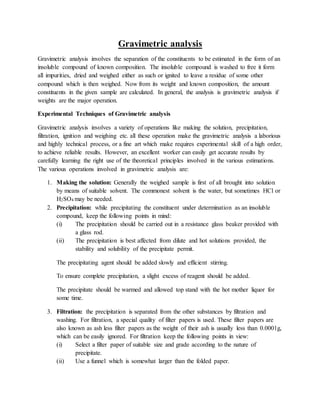
Gravimetric analysis
- 1. Gravimetric analysis Gravimetric analysis involves the separation of the constituents to be estimated in the form of an insoluble compound of known composition. The insoluble compound is washed to free it form all impurities, dried and weighed either as such or ignited to leave a residue of some other compound which is then weighed. Now from its weight and known composition, the amount constituents in the given sample are calculated. In general, the analysis is gravimetric analysis if weights are the major operation. Experimental Techniques of Gravimetric analysis Gravimetric analysis involves a variety of operations like making the solution, precipitation, filtration, ignition and weighing etc. all these operation make the gravimetric analysis a laborious and highly technical process, or a fine art which make requires experimental skill of a high order, to achieve reliable results. However, an excellent worker can easily get accurate results by carefully learning the right use of the theoretical principles involved in the various estimations. The various operations involved in gravimetric analysis are: 1. Making the solution: Generally the weighed sample is first of all brought into solution by means of suitable solvent. The commonest solvent is the water, but sometimes HCl or H2SO4 may be needed. 2. Precipitation: while precipitating the constituent under determination as an insoluble compound, keep the following points in mind: (i) The precipitation should be carried out in a resistance glass beaker provided with a glass rod. (ii) The precipitation is best affected from dilute and hot solutions provided, the stability and solubility of the precipitate permit. The precipitating agent should be added slowly and efficient stirring. To ensure complete precipitation, a slight excess of reagent should be added. The precipitate should be warmed and allowed top stand with the hot mother liquor for some time. 3. Filtration: the precipitation is separated from the other substances by filtration and washing. For filtration, a special quality of filter papers is used. These filter papers are also known as ash less filter papers as the weight of their ash is usually less than 0.0001g, which can be easily ignored. For filtration keep the following points in view: (i) Select a filter paper of suitable size and grade according to the nature of precipitate. (ii) Use a funnel which is somewhat larger than the folded paper.
- 2. The folded filter paper must fit in the funnel properly. There should be to no air gap between the filter paper and the sides of the funnel. Never fill the filter paper up to the brim. Pour the liquid to be filtered down a glass rod held against the side of the filter paper. 4. Washing: The precipitate must be washed free of all soluble impurities because otherwise impurities will remain sticking to the precipitate. The washing should be made a number of times using small volumes of the washing liquid at a time. The completeness of washing is ascertained by collected the last few drops of the filtrate and testing it for easy detectable ions. An ideal wash liquid should have following features: (i) A common ion to reduce the solubility of the precipitate. (ii) A volatile electrolyte to prevent peptization of the precipitate. (iii) An ion to prevent the hydrolysis of the precipitate. 5. Drying and ignition: When the filtration and washing is complete, the precipitate is usually dried and ignited to constant composition prior to weighing. Some precipitates however, do not require to be dried, especially if nickel or platinum crucibles are used; the precipitates do not suffer any reduction even if ignited with the filter paper. 6. Calculation for gravimetric analysis: the exact calculations involved in a particular problem depend upon the type of the problem. The result is calculated in terms of percentage of certain constituent in the sample. P= w× 100/W